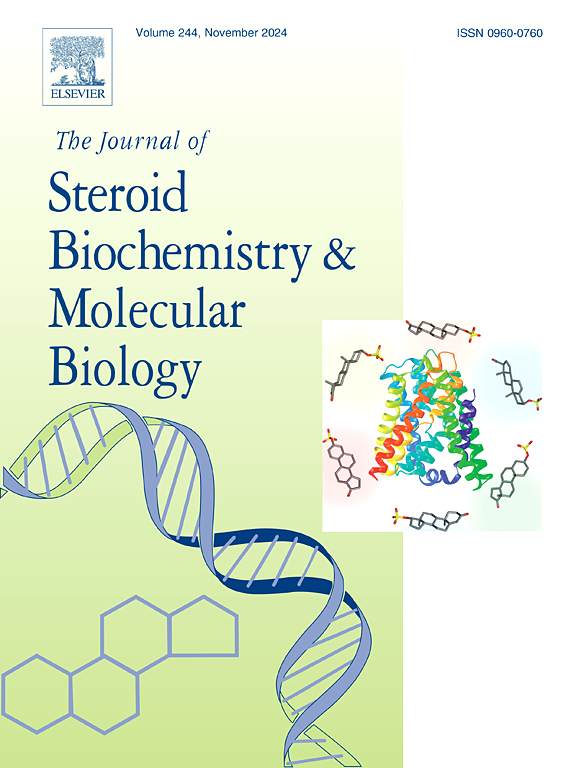Strontium regulating lipid metabolism of bovine hepatocytes via SIRT1/SREBPs pathway
IF 2.5
2区 生物学
Q3 BIOCHEMISTRY & MOLECULAR BIOLOGY
Journal of Steroid Biochemistry and Molecular Biology
Pub Date : 2025-05-20
DOI:10.1016/j.jsbmb.2025.106785
引用次数: 0
Abstract
Periparturient dairy cows are susceptible to negative energy balance (NEB), which triggers excessive adipose mobilization, leading to elevated plasma non-esterified fatty acids (NEFA) and hepatic lipid accumulation. While strontium (Sr) has shown metabolic regulatory potential, its role in hepatic lipid homeostasis remains unclear. Using an NEFA-induced lipid accumulation model in bovine hepatocytes, we demonstrated that Sr (5–20 μM) significantly reduced intracellular triglyceride (TG) and total cholesterol (TC) levels. Further mechanistic studies revealed that Sr enhances SIRT1 expression and suppresses the expression and nuclear translocation of SREBP-1C/SREBP2, thereby downregulating downstream lipogenic enzymes including ACC, FASN, SCD1, and HMGCR. Molecular docking indicated that Sr²⁺ binds with high affinity to Asp-481/483 of SIRT1, while SIRT1 inhibition with EX-527 abolished Sr-mediated lipid-lowering effects. Additionally, Sr promoted PPARα nuclear translocation to enhance β-oxidation and upregulated LDLR expression to facilitate lipid efflux. This study elucidated the multi-target molecular mechanism of Sr alleviating lipid metabolism disorders in bovine hepatocytes through the SIRT1/SREBPs pathway, providing a theoretical foundation for the application of Sr in preventing metabolic diseases in dairy cows.
锶通过SIRT1/SREBPs途径调节牛肝细胞脂质代谢
围产期奶牛易受负能量平衡(NEB)的影响,这会引发脂肪的过度动员,导致血浆非酯化脂肪酸(NEFA)升高和肝脏脂质积累。虽然锶(Sr)已显示出代谢调节潜力,但其在肝脂质稳态中的作用尚不清楚。利用nefa诱导的牛肝细胞脂质积累模型,我们证明Sr(5-20 μM)显著降低细胞内甘油三酯(TG)和总胆固醇(TC)水平。进一步的机制研究表明,Sr增强SIRT1表达,抑制SREBP-1C/ srebp - p2的表达和核易位,从而下调下游脂质酶包括ACC、FASN、SCD1和HMGCR。分子对接表明,Sr 2 +与SIRT1的Asp-481/483具有高亲和力结合,而EX-527抑制SIRT1可消除Sr +介导的降脂作用。此外,Sr促进PPARα核易位,增强β-氧化,上调LDLR表达,促进脂质外排。本研究阐明了Sr通过SIRT1/SREBPs通路缓解牛肝细胞脂质代谢紊乱的多靶点分子机制,为Sr在奶牛代谢性疾病预防中的应用提供了理论基础。
本文章由计算机程序翻译,如有差异,请以英文原文为准。
求助全文
约1分钟内获得全文
求助全文
来源期刊
CiteScore
8.60
自引率
2.40%
发文量
113
审稿时长
46 days
期刊介绍:
The Journal of Steroid Biochemistry and Molecular Biology is devoted to new experimental and theoretical developments in areas related to steroids including vitamin D, lipids and their metabolomics. The Journal publishes a variety of contributions, including original articles, general and focused reviews, and rapid communications (brief articles of particular interest and clear novelty). Selected cutting-edge topics will be addressed in Special Issues managed by Guest Editors. Special Issues will contain both commissioned reviews and original research papers to provide comprehensive coverage of specific topics, and all submissions will undergo rigorous peer-review prior to publication.

 求助内容:
求助内容: 应助结果提醒方式:
应助结果提醒方式:


